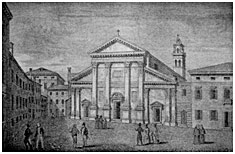|
 |
|
| THE CHIESA DI SANT’ANDREA (CHURCH OF ST. ANDREW), Piazza
Sant’Andrea - Treviso |
| |
| The Chiesa di Sant’Andrea (Church of St. Andrew) is situated in front
of Palazzo Azzoni - Avogadro on the namesake rise where, according to history, the first human settlement
was born. The development of Treviso began from here because it was in a strategic position: it was higher than the rest
of the town and it was near the river Sile. |
| |
|
The Chiesa di Sant’Andrea (Church of St. Andrew) was
born before 11th century when the bishop gave Chapter it; after some centuries, in 1780, the building was
reared again in neoclassic style by Trevisan architect Giordano Riccati (1709 - 1790). In 1834 and 1835
side naves were added, they were made by Francesco Zambon’s project and direction.
The building of the naves
had become necessary because the parishes of St. Giovanni di Riva, St. Pancrazio and St. Leonardo were
eliminated by Napoleonic decrees of 1806 and they were joined to Chiesa Sant’Andrea (Church of St. Andrew). |
 |

The Chiesa di Sant’Andrea in Treviso Antonio Nani’s engraving (Biblioteca Comunale di Treviso) |
| |
|
The Church of St. Andrew, as many other churches in Treviso (Chiesa di San Vito - Church of St. Vito - and Chiesa di Santa Lucia - Church of St. Lucy, for example),
was the seat of a school: the School of "Marangoni" (woodworkers) at the end of 16th century.
Today the fašade of the church has a central body higher than side naves, these naves, bordered by pilasters, were added some years after, when the main body
of the church was raised already; the fašade is divided in 3 parts, emphasized by 4 columns which have
high basements and at the top the composite capitals supporting a pediment with a quadrilobate hole. |
| |
|
|
 |
On the back there is the campanile, which would seem to be built before the church; this campanile has been
restored late, it has a particular and unusual shape with an octagonal base of crowning of its belfry.
With the restoration of church and campanile the
roof of the church was repaired and the old and battered plasters were replaced by others very similar
to original plasters. Indoor the church we may see some frescoes by C. Donati, these frescoes were restored
by G. Borsato after the bombings which damaged very much Treviso in the Second World War. The ancona,
situated on main altar, was painted by Bevilacqua in the first years of the 19th century.
On the left:
the Chiesa di Sant’Andrea (Church of St. Andrew) today. |
|
|


